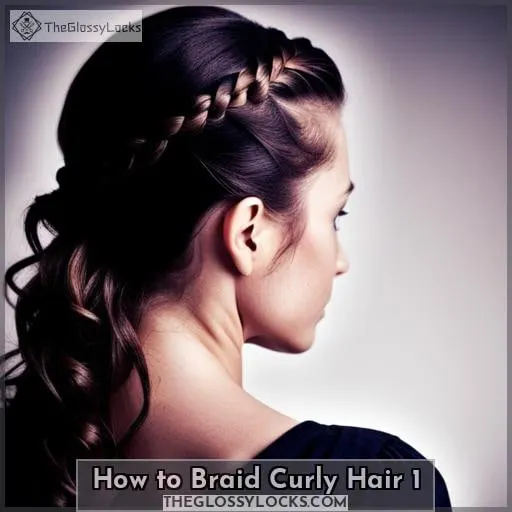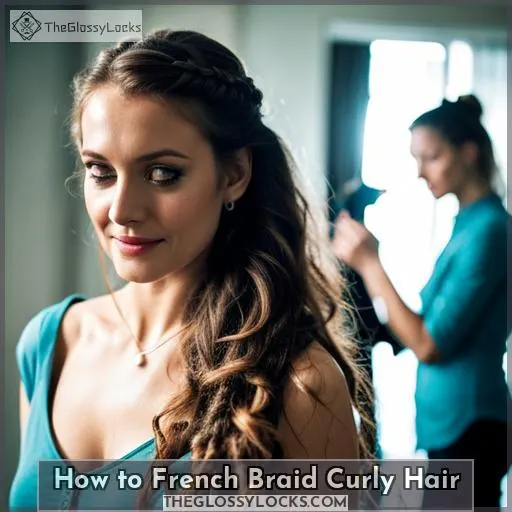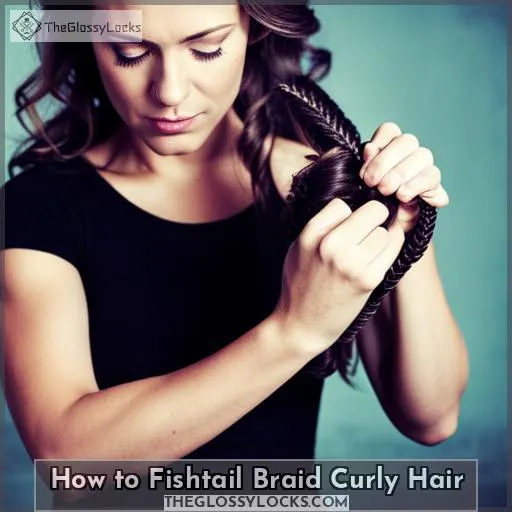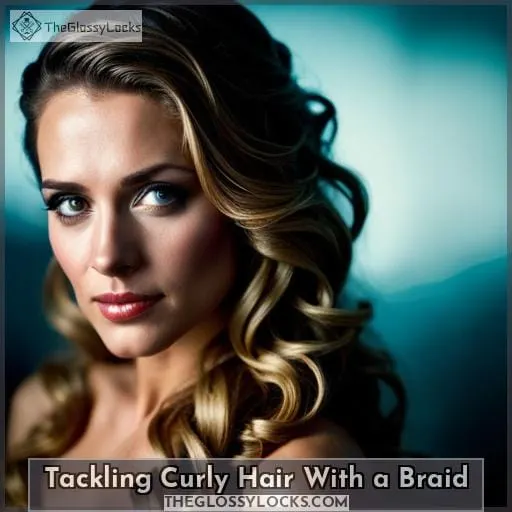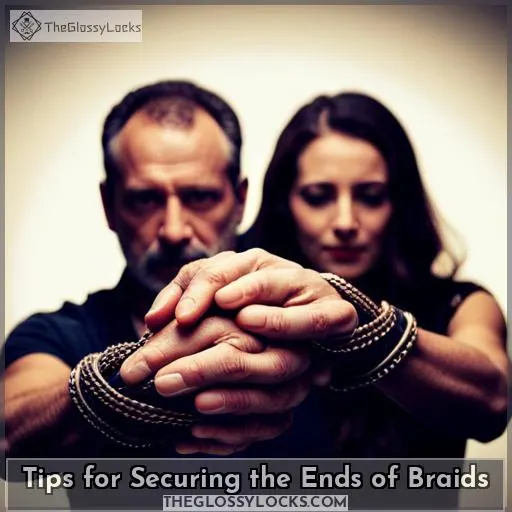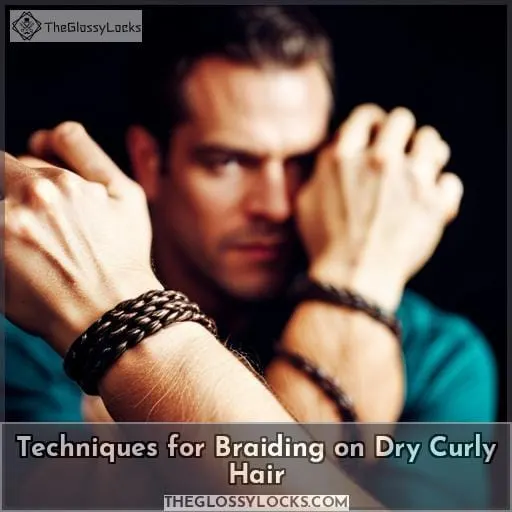This site is supported by our readers. We may earn a commission, at no cost to you, if you purchase through links.
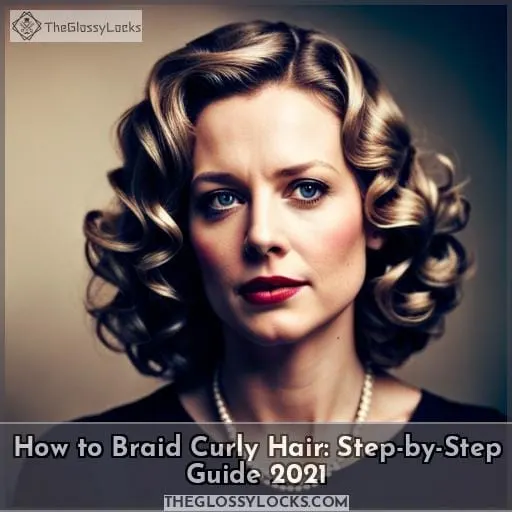 Are you having trouble figuring out how to braid curly hair? Don’t worry, we’ve got you covered.
Are you having trouble figuring out how to braid curly hair? Don’t worry, we’ve got you covered.
In this guide, we’ll walk you through step-by-step techniques for French braiding and fishtail braids that will help tame your curls in style. Plus, we’ll provide tips on prepping your locks before starting with any kind of braid so they stay put all day long.
Let’s get started – let us show you how to create stunning looks with beautiful braided styles for every occasion!
Table Of Contents
Key Takeaways
- Divide curls into smaller sections for easier handling.
- Smooth each section before braiding for even strands.
- Different braiding techniques like Dutch or French styles can create unique patterns.
- Fishtail braids can provide maximum definition for small sections of hair.
The Basics of Braiding Curly Hair
Braiding curly hair is an art form and requires a few basics to ensure the best results. To start, divide your curls into smaller sections for easier handling. Smooth each section before braiding, as this will help you produce even strands that are more uniform in size.
Finally, familiarize yourself with different braiding techniques like Dutch or French styles, which may result in unique patterns depending on how tight or loose they are done.
Sectioning Your Curls
When braiding someone else’s hair, sectioning is key to creating an even and successful style. Detangle each section with care before working on it. Use a moisture twist to maintain hydration while braiding the next sections.
Dutch braid for lifted braid outs or French braid for a zig-zag pattern in curly hair, but be aware of tighter sections resulting in more defined curls. For dry curly hair, blow drying and stretching can maximize length but may cause damage if done too often; alternatively, try fishtail braids as they require less tension than other styles like box braids, which could lead to breakage or excessive loss of curl definition/hair volume over time.
Section your curls wisely!
Smoothing Your Hair
Smooth your strands before braiding for a successful style that will last! Utilize these five tips to ensure optimal curly hair maintenance:
- Moisturize using Buildup Buster and Heaven in Hair.
- Detangle with care, being sure not to pull too hard.
- Pull the outside piece when starting any braid styles at the nape of your neck.
- Choose tight hairstyles like regular double braids sparingly as they can cause breakage and loss of curl definition/volume over time.
- Dutch or French braiding is kind of the most versatile. Be mindful when sectioning curls – practice makes perfect!
With proper smoothing methods, you’ll be able to create beautiful protective styles without causing damage.
Braiding Techniques
Try your hand at different braiding techniques to create a variety of hairstyles. The average woman spends over 200 hours in her lifetime on hair styling. For heatless styling and protective styles, use a wide-toothed comb and sectioning clips or bands to achieve perfect results.
To practice technique, start by making three sections. Top tribal braids are great for beginners! As you braid each section separately from the middle part outwards towards one side while crossing it over the next cross piece.
When finished, remove any elastics used during weaving with care so that curls stay intact after removal. Don’t forget about regular practice as this is key in mastering these intricate designs.
How to French Braid Curly Hair
Are you looking to master the art of French braiding curly hair? With a few simple steps and helpful tips, you can easily create a beautiful zigzag pattern on your locks.
Step-by-Step Guide to French Braiding
To master the art of French braiding, start by dividing your locks into smaller sections and brushing out any knots or tangles.
Moisture is essential for achieving definition, so consider adding a twist to maintain hydration while working on each section.
A braid queen knows that French braids are best done on wet hair, but they can also be achieved with dry strands if blow-drying and stretching beforehand is an option.
For curly hairstyles, Dutch braiding yields lifted braid outs, whereas French braids may result in zigzag patterns depending on how tight or loose you do it!
Fishtails can also be used for more defined curls when working with small sections of hair too – just remember the basics of good quality moisture retention and smoothness prior to starting your style!
Tips for Creating a Zig-Zag Pattern
For a zig-zag pattern, experiment with different braiding styles like French and fishtail. These mimic the winding roads of an adventurous journey! Make sure to maintain moisture retention for healthy hair – blow-drying or stretching dry strands can damage it.
Before starting your style, apply a strand twist or conditioner to hydrate and moisturize each section properly.
How to Fishtail Braid Curly Hair
Are you ready to master the art of fishtail braiding for curly hair? Look no further! With a step-by-step guide and helpful tips, you can easily create defined curls with this stunning hairdo.
Step-by-Step Guide to Fishtail Braiding
Grab your brush and section off the hair you want to work with. Then, learn how to create a beautiful fishtail braid in no time! Start by braiding wet hair for the best results. Make sure that each curved section is smooth before beginning. To add volume, do three separate braids instead of two.
This will help avoid damage as well. Secure all ends with a tie so they don’t fray or come apart while styling friends’ hair later on! Don’t forget the handy dandy guidebook – it has great tips on creating different types of braids using very small sections of hair.
Creating Defined Curls With Fishtail Braids
By creating smaller sections and braiding tightly, you can achieve defined curls with a fishtail braid that will last! With the right techniques, like using a twist to retain moisture while separating mini sections of hair, your braid out can be full of tighter curl patterns.
To get the best results on curly-textured hair, it’s important to cleanse with Buildup Buster, then condition with Heaven in Hair before starting. Don’t forget good braiding tips like detangling wet strands for elongation and smoothing locks prior to styling.
If dry braiding is necessary, use blow drying or stretching pre-braided pieces for maximum length, but take precautions against possible damage.
Tackling Curly Hair With a Braid
Are you ready to tackle your curly hair with a braid? Before styling, it’s important to properly prepare your hair for braiding. Set your curls for maximum effect by cleansing and conditioning, then detangle them while they are still wet.
Sectioning and using the appropriate braiding techniques will ensure that you achieve the desired results of defined locks or an exquisite updo.
Prepping Your Hair for Braiding
Before braiding, it’s important to ensure your hair is properly prepped for the best results. Moisturizing methods like a reparative mask and curl stretching can help maintain majestic curls while also increasing braid longevity.
To create tension control throughout the style, you’ll want to start with outside sections and work towards the middle position with the help of a styler or blow dryer.
Finally, detangling each section of your curls will leave you with long-lasting waves that are nothing short of spectacular!
Setting Your Curls for Maximum Effect
Once you’ve got your hair prepped, it’s time to set those curls for maximum effect. For a protective style, braid outs are great for texture and definition. Try twisting each individual section before braiding.
If dry braiding is an option for your hair type, use a deep sea repair mask beforehand and finish with a silicone-free hairspray like Candlenut Oil Mist.
To preserve length when styling out the braidouts in the future, detangle gently with a wide tooth comb or finger coils instead of brushing from root to end. This will help keep breakage at bay! Choose between French or fishtail braids depending on how much curl definition you want while ensuring every strand stays put during wear.
With all these tips in mind, there’s no limit to what kinds of hairstyles you can create using protective styles!
Sectioning and Braiding Techniques
You can achieve stunning results by sectioning and carefully braiding your locks, twisting sections to maintain moisture while working. Whether you’re a curly girl or a friend who wants to braid someone else’s hair, understanding the basics of different styles will help you get better with each practice.
A herbal leave-in conditioner should be used before wet braiding for best results. Dutch and French braids are great options for lifted braidouts, while fishtail works well when defining curls is important.
With a few tips in mind and regular practice on friends’ hair, anyone can become fabulous at styling curly strands into different shapes!
Tips for Securing the Ends of Braids
Are you looking for the best way to secure your braids and prevent fraying? Choosing the right method according to your hair type is essential in order to get a great result.
Preventing Fraying With Hair Ties
Secure your braids with a hair tie to prevent fraying and create long-lasting styles. Use the proper technique when detangling and sectioning damp or dry hair for best results.
To avoid damage, use a separate hair care routine such as blow-drying on low heat or using detangling sprays before styling. When braiding, use products like coconut oil for extra hold and secure ends with a silk scrunchie instead of elastic bands that can pull at curls too much.
Make sure to braid sections in an alternating pattern between left and right hands for even tension throughout the style! Finish off by sealing flyaways with hairspray if desired – this will help protect your locks from frizz while enhancing shine!
Choosing the Right Method for Your Hair Type
Choosing the right method for your hair type can make all the difference when it comes to creating a beautiful braid style – so don’t settle for anything less than spectacular!
First things first, straight hair requires more product and styling techniques compared to curly/wavy textures. Protecting hair is important, so use heat protection sprays before blow-drying or stretching curls.
Use a light cream or leave-in conditioner with hold properties and secure ends with silk scrunchies instead of elastic bands that can pull at curls too much.
For those blessed with natural curl texture, they should opt for products specifically designed to work well on their specific curl pattern like coconut oil, which will help define each strand while also protecting against frizziness and breakage.
Braiding wet versus dry depends on preference – either way, practice makes perfect! Choose the right technique based on your desired outcome: Dutch braids are great if you want lifted results; French braids create lovely zigzag patterns; Fishtail works perfectly if you’re looking for definition in smaller sections — just be sure not to forget about sectioning as this step is key regardless of what braid style you choose!
Techniques for Braiding on Dry Curly Hair
Braiding curly hair on dry strands can be a bit of a challenge, but with the right technique and preparation, it is possible to achieve great results. If you want to maximize length and definition while braiding on dry curls, then blow-drying and stretching before you braid can help get the job done – just make sure that your heat settings are low enough so as not to cause any damage! With patience, practice, and some know-how, you’ll soon master this art form.
Challenges and Solutions for Dry Hair Braiding
Braiding dry curly hair can be a challenge, but with the right techniques, you’ll be able to achieve great results. Start by choosing the best braiding tools for your type of curls and use them when styling your hair.
Apply a rinse-out conditioner before beginning, as this will help retain moisture and prevent damage.
When using wet styling methods, consider using pattern variations such as cornrows or Dutch braids to create beautiful results without sacrificing length or volume.
Lastly, don’t forget that practice makes perfect, so keep trying until you master it!
Maximizing Length With Blow Drying and Stretching
Blow drying and stretching your hair prior to braiding can help maximize length with minimal damage. Select the best blow drying techniques for your unique curl type, then use a good detangling product before you begin.
Focusing on increasing blood circulation is essential in order to ensure curls don’t frizz and stay bouncy during the process of styling.
Follow a step-by-step process since this will result in even more definition for your beautiful locks! Lastly, don’t forget that practice makes perfect, so keep trying until you master it – there’s nothing quite like having healthy and long curls from braid outs or any other style!
Frequently Asked Questions (FAQs)
How long should I leave my braids in for best results?
For best results, leave your braids in for as long as you feel comfortable. If desired, secure ends with a hair tie to prevent fraying.
What products should I use to braid my curly hair?
For best results, use Buildup Buster to cleanse and Heaven in Hair to condition your curly hair before braiding. Detangle with a twist for moisture and smooth down the sections. Secure ends with a hair tie for protection.
How often should I braid my hair?
How often you braid your hair depends on the style and desired results. Consider protective styles, hair setting, or creating various hairstyles. If braiding for a braid out, try to do it every 2-3 weeks. For more volume, three braids are better than two! Practice helps create the best results with minimal damage to curly locks.
Do I need to blow dry my hair before braiding?
Blow-drying your hair before braiding can maximize length, but it may cause damage. Wetting the hair and using a twist to maintain moisture is an alternative option for achieving defined curls.
Is braiding curly hair difficult?
Braiding curly hair can be challenging, but with practice, you’ll find it easier.
Conclusion
Braiding curly hair is an art form that takes practice and patience to perfect. With the right techniques, you can create beautiful hairstyles that last and look amazing. Whether you opt for French, fishtail, or Dutch braids, the key is to ensure that you prep and section your hair properly and that you choose the right tools and products to keep your curls moisturized.
Once you’ve mastered the basics of braiding curly hair, you’ll be able to create stunning looks with ease.

